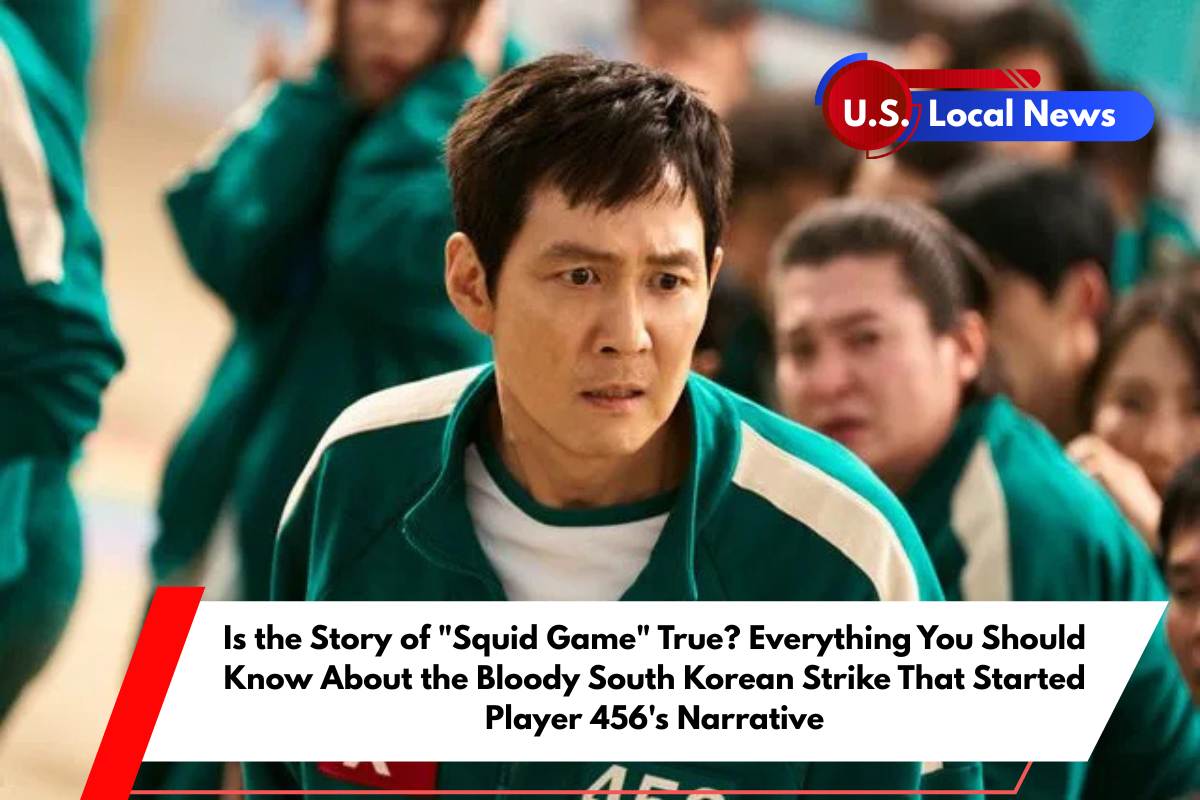Squid Game is a dystopian nightmare for its players, based on real-life events.
The third and final season of the South Korean show premiered on Netflix on June 27. It concludes the story of Seong Gi-hun (Lee Jung-jae), whose backstory is based on the Ssangyong Motor strike. The series demonstrates how much people are willing to sacrifice and endure for financial gain, a goal accomplished through deadly children’s games.
In a June 2025 interview with The New York Times, creator Hwang Dong-hyuk stated that he believes the series became a streaming phenomenon because “we touched something in the zeitgeist through Squid Game.”
“The sense of urgency, the sense of crisis that weighs heavily on people’s daily lives, it allows anyone to easily relate to Gi-hun,” he insisted. “That I tackled the issues of society’s limitless competition through children’s games, that contrast appealed to a lot people.”
Throughout the series, viewers see Gi-hun’s financial and social struggles while his dramatic past is hinted at. The character’s turmoil is a work of fiction, but the historical events that inspired it are not.
Here’s everything you need to know about Squid Game, which was inspired by true events.
Is Squid Game based on a true story?
Squid Game is not based on a true story, but was inspired by the Ssangyong Motor Strike, a violent event in South Korean history.
The ordeal served as the basis for Gi-hun’s origin story. In a 2021 Agence France-Presse (AFP) interview (via NME), Hwang explained that by referencing the strike, he “wanted to show that any ordinary middle-class person in the world we live in today can fall to the bottom of the economic ladder overnight.”
“I think viewers around the world deeply relate to the theme of economic inequality portrayed in Squid Game,” according to the author.
What was the Ssangyong Motor strike?
According to People’s Dispatch, the incident occurred when China’s Shanghai Automotive Industry Corporation (SAIC) declared bankruptcy in January 2009.
The company owned a controlling stake in South Korea’s Ssangyong Motor Company, and the bankruptcy resulted in mass layoffs for Ssangyong.
According to The New York Times, approximately 2,000 employees voluntarily left the company in the following weeks. In April 2009, Ssangyong announced that it would cut 36% of its remaining workforce, including all 970 employees at its Pyeongtaek, South Korea, plant.
The following month, factory workers staged a 77-day sit-in, which resulted in violent and fiery clashes with police. According to Peoples Dispatch, the conflict was “among the most fierce workers’ struggles South Korea has witnessed in almost two decades.”
The strike began with over 900 participants, but that number dwindled after a court order was issued to end the event and police turned off the factory’s water, according to The New York Times.
According to The Japan Times, police used rubber bullets and tasers against striking workers.
How did the Ssangyong Motor strike end?
The sit-in at the plant, which “had virtually become a war zone,” came to an end after 77 days, according to The New York Times.
The union and Ssangyong management reached an agreement, and the company retained 48% of the factory’s jobs. Despite the tension, the union and management indicated that the majority of strike participants’ jobs would be saved.
Nonetheless, some employees faced consequences for their participation in the event. According to Labour Notes, the striking workers “were blackballed from employment with other large Korean companies.”
Unable to find work and forced to pay fines for union activity, they fell into financial debt, resulting in the courts seizing the workers’ wages and assets.
According to the outlet, “13 Ssangyong workers and family members died by suicide as a result of anti-union oppression between 2009 and 2011.” Between 2009 and 2018, an additional 30 SsangYong employees committed suicide for similar reasons.
Others reportedly died as a result of stress caused by the fallout, according to The Korea Herald.
How did the Ssangyong Motor strike inspire Squid Game?
The Ssangyong Motor strike inspired the storyline of Squid Game’s main protagonist, Gi-hun.
The first episode of the series reveals that Gi-hun was laid off from his assembly job at Dragon Motor, a car manufacturing plant, ten years ago. The name Dragon Motor appears to be a nod to Ssangyong, which means “double dragons” in English.
Like at the Ssangyong factory, Gi-hun and his coworkers went on strike, resulting in a violent clash with the police — a scene depicted briefly in episode 5 of the first season of Squid Game.
What have the Ssangyong Motor strikers said about Squid Game?
In December 2024, Lee Chang-kun, a former Ssangyong Motor employee and union leader who took part in the strike, told The Japan Times that Squid Game’s immediate streaming success left him feeling “empty and frustrated.”
“[When season 1 premiered], it felt like the story of the Ssangyong workers had been reduced to a commodity in the series,” he told me. “Many people have lost their lives. “People had to suffer for far too long.”
Chang-kun went on to say, “We were viewed as incompetent breadwinners and outdated labour activists who had lost their minds. Police continued to beat us even after we fell unconscious; this occurred at our workplace and was broadcast for all to see.”
Regarding the show is plotlines, Chang-kun wrote in a November 2021 feature for Jacobin that “the order of games in Squid Game resembles the phases of agony Ssangyong workers had to undergo — indeed, the plot appears to be inspired by the seventy-seven-day occupation.”
“We were suddenly forced to squat in the factory. “We first tried to rely on each other to survive,” he said. “However, we were thrown into a life-or-death situation, often with no other option but to betray and dupe each other.”
Chang-kun, like the characters in Squid Game, recalled how the Ssangyong employees “each had to hurt our closest friends.” He went on: “By the time the police raided the strike, there were only about 700 of us left, and mistrust of our coworkers nearly outweighed our trust.”
While their story has gained international attention, Chang-kun told The Japan Times that it has had little impact on the South Korean workforce’s practices.
“Despite being widely discussed and consumed, it is disappointing that we have not channelled these conversations into more beneficial outcomes,” the president stated.
Was Squid Game inspired by anything else?
Squid Game was inspired by the Ssangyong Motor Strike, as well as some pop culture references.
In a September 2021 interview with Variety, Hwang stated that he drew inspiration from Japanese comics and anime.
“When I started, I was in financial straits myself and spent much time in cafes reading comics including Battle Royale and Liar Game,” according to him.
Hwang continued, “I began to wonder how I would feel if I participated in the games myself. But I found the games too complex, so for my own work, I focused on using children’s games.













